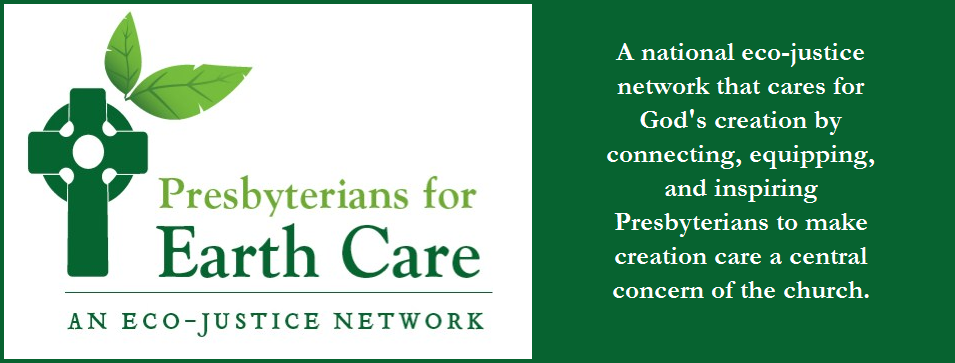Investing in a Green Future: A Vision for a Renewed Creation
by Rev. Sue Smith
From The Power to Speak Truth to Power
(1981) to Restoring Creation
for Ecology and Justice (1990) to The Power to Save
(2008), the PCUSA has a long history of environmental policy providing us with
guidance in caring for all of God’s creation. The 223rd General
Assembly (2018) directed the Advisory Committee on Social Witness Policy
(ACSWP) to develop a policy to respond to the increasing impacts of climate
change. Building on our existing policies, Investing in a Green Future: A Vision for a Renewed Creation
lifts up the intersection of environmental, economic and racial justice, to
ensure that actions address how a warming planet affects all creation.
This paper was recommended to the 224th
General Assembly (2020). In 2020 we were celebrating the 30th
anniversary of Restoring Creation for Ecology and Justice and designed a poster
celebrating over 50 years of environmental advocacy in the PCUSA. In an
in-person Assembly, we would have celebrated in style. But it was not an
in-person Assembly and the paper was referred to this year’s 225th
General Assembly.
Restoring Creation for Ecology and Justice called
for the 1990’s to be the turnaround decade for ecological restoration. We did
not respond to the cry of creation then – we need to recommit to a turnaround
decade now. It is not enough to be the turnaround decade outlined in 1990.
Today we need to be intentional about addressing the intersection of
environmental, economic and racial justice, aligning with the Church’s focus on
Matthew 25 and dismantling systemic racism.
Overtures to General Assembly tend to recognize that we
need to keep the needs of “the least of these” as a focus in our work and then
go on to promote market solutions that favor those that profit from capitalism.
We know that BIPOC folx (black, Indigenous and people of color) and women are
most vulnerable to climate change and the least likely to profit from
capitalism. How might the Church address these needs? Here are some of the
recommendations:
·
Support policies and regulations that rigorously
reduce air pollution, not only carbon pollution, but also particulate matter
and other carcinogenic air pollutants that disproportionately affect
low-income, vulnerable communities of color living near regulated facilities
and power plants. (8B)
·
Ensure that communities affected by
environmental racism are included at the table and have the opportunity to
provide leadership in the movement to find solutions to the current ecological
crisis. (8Ca)
·
Affirm those who suffer most have the strongest
moral claim in shaping restorative policy and practice. (8Cc)
·
Reiterate that the goal of a “green economy”
cannot be limited strictly to ecological concerns or environmental policy, but
must address concerns of racial and economic justice in the marketplace,
including a living wage; access to safe, affordable housing, health care, and
food; rigorous regulation of high-polluting sectors and industries; programs to
replace and retrofit aging buildings and infrastructure; access to jobs and job
training in sustainable industries; and workforce development programs for
workers who will transition from the fossil fuel industry to sectors with
renewable and sustainable practices. Recognize that economic justice is
important especially for women, who bear the brunt of many climate impacts.
(8F)
Will the recommendations made be easy? No. One of the final recommendations: Recognize that transitioning to a more just, restored, and sustainable world will be difficult, but possible. While it is hard for us to imagine a low-carbon / zero-carbon economy without fossil fuels, where environmental care comes before profit, in which racism and poverty are functionally eliminated, we must do all of these things. Instead of focusing on the difficulties or expense, we must lift up our vision and actions to create a revived environment, better health outcomes, employment opportunities that provide a living wage, clean air and water, wilderness preserved for its own sake, universal access to healthy food, and the reconciliation of broken relationships. (9)
May it be so.
Sue Smith put her
MBA to work in the global financial services industry for 30 years. She is an
ordained minister and Stated Clerk of the Presbytery of the Coastlands (NJ).
She is the co-chair of the Advisory Committee on Social Witness Policy. She
serves on the boards of Clean Water Action (NJ) and Waterspirit and was a
former steering committee member of Presbyterians for Earth Care.



